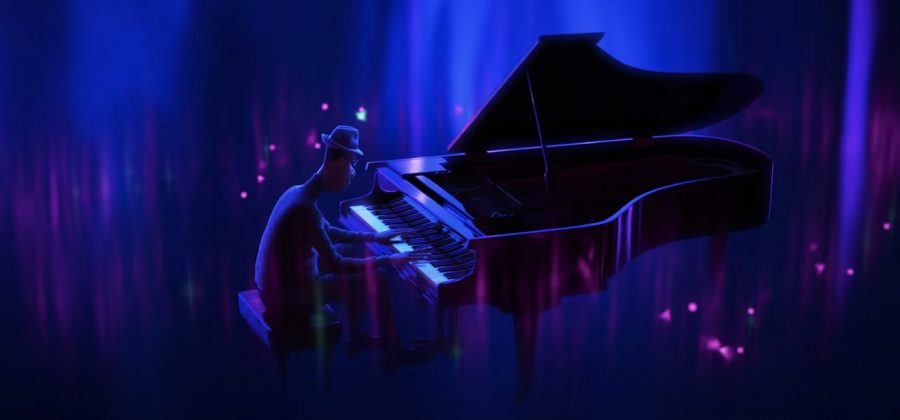The latest Pixar film fails to reach everyone’s “Soul”
TRANSPOSED: Protagonist Joe Gardner allows himself to perform “in the zone” when he first rehearses with Dorothea Williams.
January 25, 2021
Pixar’s “Soul” is a bold animation that is not afraid of throwing existential questions to its audience. It offers a soul’s unique perspective of all the problems and questions humanity continuously grapples with. By the time the credits roll around, the film accomplishes the considerable feat of keeping the audience entertained, enlightened and pondering for more. However, “Soul” also exhibits many flaws that cannot be left to go unnoticed.
The film begins with middle school band teacher Joe Gardner (Jamie Foxx) trying to teach music to his clearly uninterested students. When he is offered a job as a permanent teacher, Gardner feels discouraged, as he must leave his dream of being a musician behind, that is until he is called for a gig with legendary jazz performer Dorothea Williams (Angela Bassett). On his way home after the audition, he falls into a hole and a coma (as later revealed), as he sees souls lining up to cross over to the Great Beyond.
In an attempt to return back to his body, Gardner lands up in the Great Before, where he meets cynical 22 (Tina Fey), a soul who requires a mentor to help her find a spark before she can go to Earth. Desperately wanting to return to his gig, Gardner agrees to be her mentor, but 22 ends up in Gardner’s body and Gardner’s soul ends up in a cat.
“Soul” carries a deep and comforting message that the pressure of finding a goal or purpose in life can blind people from the simple joys it presents. In a way, the movie comforts the older youth who are often pressured by society to figure out the grand scheme of one’s life earlier on in their lives, and it sends a message of hope to those who are feeling hopeless especially during the coronavirus pandemic. But it was disheartening to see the film utilize the trope of characters of color being turned into creatures. Instead of a frog, this time, it was a soul and then a cat.
As a soul that inhabits a cat, Gardner remains helpless from making his own decisions and changing his life. Instead, he watches from the side as 22 saves him from his depressing life. Throughout the film, there are friends and family members that offer priceless advice on following one’s dreams and passions, such as Gardner’s friend that continues to be a barber despite his previous aspirations, and Gardner’s mother who talks about the practicality of one’s ideal career. Yet, it took a separate character (voiced by a white woman) for Gardner to reach an epiphany about the beauty of life.
Additionally, Pixar’s animated films are often geared towards a child audience. However, in comparison to its other films such as “Inside Out” which taught the importance of different emotions and core values and “Onward” which taught about confidence, “Soul” introduced too many complex ideas at once. In slightly over 100 minutes, “Soul” tries to introduce how personalities are decided before a soul enters Earth, how a certain number of souls must die each day and how obsessions can trap a person in a continuous spiral of dark thoughts, making it difficult for the audience to focus on the overall plot.
However, not all aspects of the film were disappointing. “Soul” made history as the first Pixar film to include a black lead and a mainly black cast for principal characters. Director Pete Docter and the rest of the team made many efforts to accurately represent black culture within their work, as they regularly consulted with a group of black Pixar animators and artists as well as Dr. Peter Archer, a middle school band teacher in New York City that inspired the film.
“Pete Docter’s famous question was, “Did I get this right?” Archer said in an interview with Patch. “I was giving advice. I was giving ideas. We were trying to make things realistic and help shape the movie.”
Moreover, the soundtrack created by renowned musician Jonathan Batiste and Nine Inch Nails members Trent Reznor and Atticus Ross brings the genres of jazz, R&B and soul to life. In contrast with the orchestral score that typically accompanies Pixar films, the soundtrack for “Soul” helps the audience focus on the technique of improvisation and each musician’s joy for music. Another noteworthy feature of the film is the intricate animations complementing Gardner’s piano playing.
“We recorded video reference of Jon Batiste’s hands as he played the piano [which]…served as a visual roadmap,” animator MontaQue Ruffin said. “This allowed the animator to create a first pass of general hand placement, and once that was tied down, the animator then layered in the fingers and other nuance details until the animation was completed.”
Vastly different from the storyline, there were many scenes that possess beautiful visuals, such as when Gardner is lost in “the zone” as he was improvising for Williams. With peaceful hues of dark blue and purple moving around Gardner, the animations brilliantly capture the emotional state of performers when their passion and spirit control the very notes they perform.
For those wanting to view the film, “Soul” is available on Disney+, and its soundtrack can be streamed on Spotify, Apple Music and other platforms.
Overall, “Soul” carries an uplifting message that assures the audience that they do not need to find a clear purpose in life in order to feel happy and content. It introduces a diverse cast, genres of music unfamiliar to many and enchanting visuals that can leave a smile on one’s face. However, the impracticality of the complexity of its plot for the younger audience and its use of a racial trope prevents this film from becoming a Pixar classic.

























































